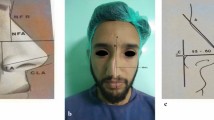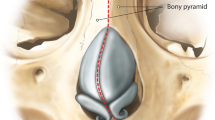Abstract
Crooked nose is mostly characterized by a deviation of both the bone and the cartilaginous parts of the nose. In order to obtain proper functional and improved esthetic results, both of these parts have to be corrected. The objective of this study is to evaluate the esthetical and the functional outcomes following correction procedures of the bone pyramid through internal microperforating technique and the cartilaginous part through subtotal septal reconstruction. The medical records of 158 patients who have undergone through primary septorhinoplasty for crooked nose treatment during the period of 21 June 2016 and 31 July 2017 have been reviewed. Functional results have been evaluated using the Nasal Obstruction Symptom Evaluation (NOSE) scores and the esthetical results through Rhinoplasty Outcome Evaluation (ROE) scores. The observation times have been arranged preoperatively as 6 months–1 year (group 1) and 1–2 years (group 2). Septorhinoplasty procedure has been performed on 158 patients with crooked noses. Out of this number, 104 of the patients (65.8%) were women and 54 were men (34.2%). The average age of the patients was 31.59 (9.3%), all of who have undergone this procedure. There was a significant improvement (P < 0.001) in the NOSE and the ROE scores of group 1 and group 2, which was statistically significant. There was no difference between group 1 and group 2. In crooked nose treatment, correction of the deviated bone pyramid using internal microperforating osteotomy and correction of the severely deviated septum using subtotal septal reconstruction yield improved functional and esthetic results.
Level of Evidence: Level V, therapeutic study.











Similar content being viewed by others
References
Gerbault O, Daniel RK, Kosins AM (2016) The role of piezoelectric instrumentation in rhinoplasty surgery. Aesthet Surg J 361:21–34 Google ScholarCrossRefPubMed
Gubisch W (2005) Extracorporeal septoplasty for the markedly deviated septum. Arch Facial Plast Surg 7(4):218–226
Most SP (2006) Anterior septal reconstruction: outcomes after a modified extracorporeal septoplasty technique. Arch Facial Plast Surg 8(3):202–207
Toriumi DM (1994) Subtotal reconstruction of the nasal septum: a preliminary report. Laryngoscope 104(7):906–913
Ross Mobley S, Long J (2016) Extracorporeal septoplasty: assessing functional outcomes using the validated Nasal Obstruction Symptom Evaluation score over a 3-year period. Plast Reconstr Surg 137(1):151e–163e
Russell WH, Kridel MD, Bruce A, Scott MD, Hossam MT, Foda MD (1999) The Tongue-in-Groove Technique in septorhinoplasty: a 10-year experience. Arch Facial Plast Surg 1(4):246–256
Mau T, Mau ST, Kim DW (2007) Cadaveric and engineering analysis of the septal L-strut. Laryngoscope 117(11):1902–1906
Lee SJ, Liong K, Lee HP (2010) Deformation of nasal septum during nasal trauma. Laryngoscope 120(10):1931–1939
Alsarraf R (2000) Outcomes research in facial plastic surgery: a review and new directions. Aesthet Plast Surg 24(3):192–197
Stewart MG, Witsell DL, Smith TL, Weaver EM, Yueh B, Hannley MT (2004) Development and validation of the Nasal Obstruction Symptom Evaluation (NOSE) scale. Otolaryngol Head Neck Surg. 130(2):157–163
Stewart MG, Smith TL, Weaver EM et al (2004) Outcomes after nasal septoplasty: results from the Nasal Obstruction Septoplasty Effectiveness (NOSE) study. Otolaryngol Head Neck Surg 130(3):283–290
King ED, Ashley FL (1952) The correction of the internally and externally deviated nose. Plast Reconstr Surg (1946) 10(2):116–120
Gubisch W (1995) The extracorporeal septum plasty: a technique to correct difficult nasal deformities. Plast Reconstr Surg 95:672–682
Çakır B, Öreroğlu AR, Doğan T, Akan M (2012) A complete subperichondrial dissection technique for rhinoplasty with management of the nasal ligaments. Aesthet Surg J 32(5):564–574
Gabra N, Rahal A, Ahmarani C (2014) Nasal osteotomies: a cadaveric study of fracture lines. JAMA Facial Plast Surg 16(4):268–271
Paul N, Messinger K, Liu YF, Kwon DI, Kim CH, Inman JC (2016) A model to estimate L-strut strength with an emphasis on thickness. JAMA Facial Plast Surg 18(4):269–276
Yuan F, Liu MD, Kelton Messinger BS, Jared C, Inman MD (2017) Yield strength testing in human cadaver nasal septal cartilage and L-strut constructs. JAMA Facial Plast Surg 19(1):40–45
Surowitz J, Lee MK, Most SP (2015) Anterior septal reconstruction for treatment of severe caudal septal deviation: clinical severity and outcomes. Otolaryngol Head Neck Surg 153(1):27–33
Asher SA, Kakodkar AS, Toriumi DM (2018) Long-term outcomes of subtotal septal reconstruction in rhinoplasty. JAMA Facial Plast Surg 20(1):50–56
Spataro E, Piccirillo JF, Kallogjeri D et al (2016) Revision rates and risk factors of 175 842 patients undergoing septorhinoplasty. JAMA Facial Plast Surg 18(3):212–219
Constantian MB (2005) The boxy nasal tip, the ball tip, and alar cartilage malposition: variations on a theme: a study in 200 consecutive primary and secondary rhinoplasty patients. Plast Reconstr Surg 116(1):268–281
Gunter JP, Friedman RM (1997) Lateral crural strut graft: technique and clinical applications in rhinoplasty. Plast Reconstr Surg 99(4):943–952
Toriumi DM, Asher SA (2015) Lateral crural repositioning for treatment of cephalic malposition. Facial Plast Surg Clin North Am 23(1):55–71
Sheen JH (1978) Aesthetic rhinoplasty. Mosby–Year Book Inc, St Louis
Ilhan AE, Saribas B, Caypinar B (2015) Aesthetic and functional results of lateral crural repositioning. JAMA Facial Plast Surg 17(4):286–292
AF K, Cano SJ, East CA et al (2016) Development and psychometric evaluation of the FACE-Q scales for patients undergoing rhinoplasty. JAMA Facial Plast Surg. 18(1):27–35
Lee MK, Most SP (2016) A comprehensive quality-of-life instrument for aesthetic and functional rhinoplasty: the RHINO scale. Plast Reconstr Surg Glob Open 4(2):e611
Barone M, Cogliandro A, Di Stefano N, Tambone V, Persichetti P (2017) A systematic review of patient-reported outcome measures after rhinoplasty. Eur Arch Otorhinolaryngol 274(4):1807–1811
Byrne M, Chan JC, O’Broin E (2014) Perceptions and satisfaction of aesthetic outcome following secondary cleft rhinoplasty: evaluation by patients versus health professionals. J Craniomaxillofac Surg 42:1062–1070
Author information
Authors and Affiliations
Corresponding author
Ethics declarations
Funding
The authors received no funding for this study.
Conflict of interest
Hadi Nural declares that he has no conflict of interest.
Ethical approval
All procedures performed in studies involving human participants were in accordance with the ethical standards of the institutional and/or national research committee and with the 1964 Helsinki Declaration and its later amendments or comparable ethical standards. For this type of study, formal consent is not required.
Informed consent
All patient cases were performed only after obtaining informed consent for the surgical procedure.
Patient consent
Patients provided written consent for the use of their images.
Electronic supplementary material
ESM 1
(MP4 166131 kb)
Rights and permissions
About this article
Cite this article
Nural, H. Esthetic and functional result of crooked nose treatment; internal microperforating osteotomy and subtotal septal reconstruction. Eur J Plast Surg 42, 135–144 (2019). https://doi.org/10.1007/s00238-018-1469-1
Received:
Accepted:
Published:
Issue Date:
DOI: https://doi.org/10.1007/s00238-018-1469-1




